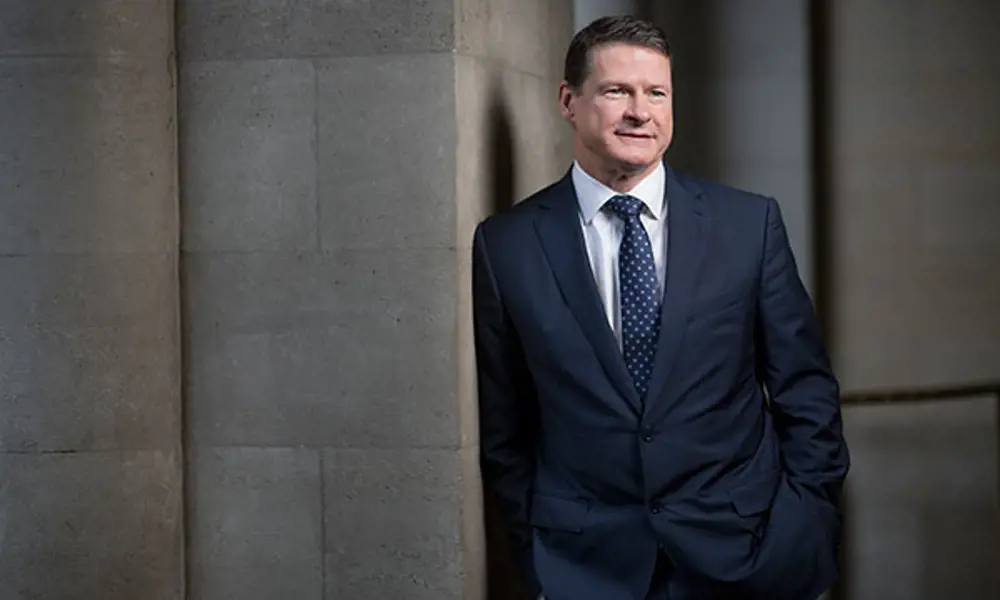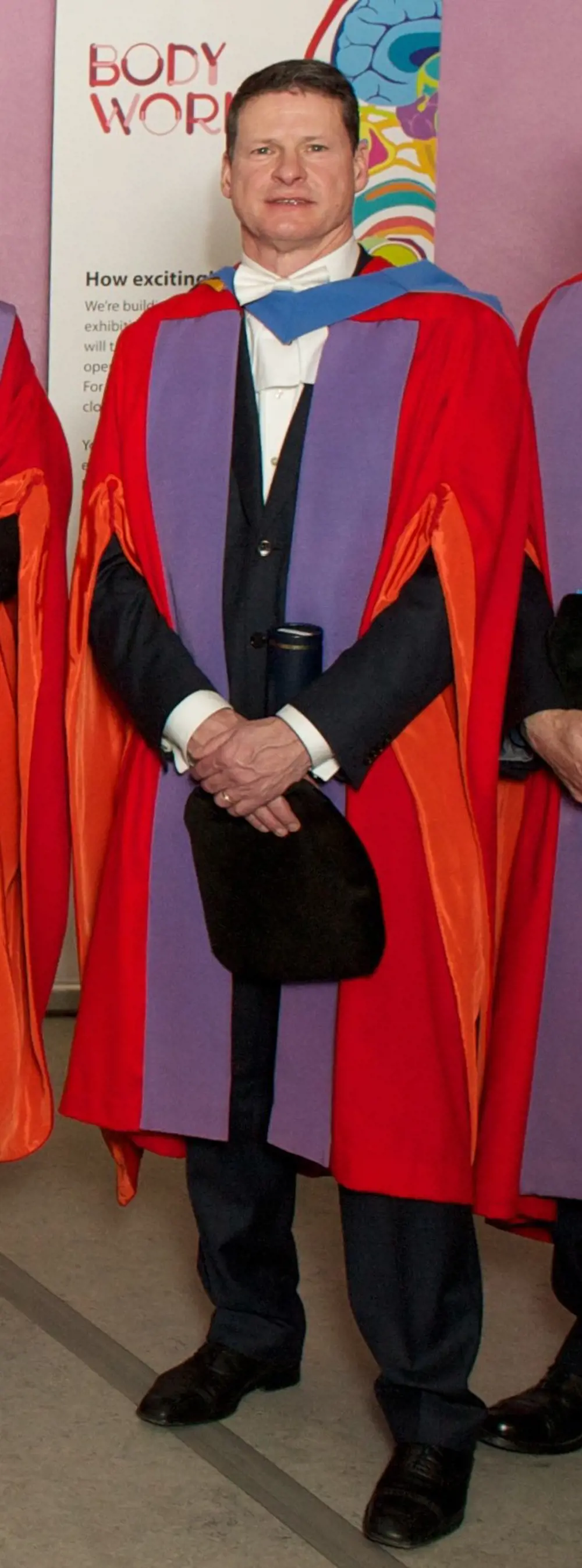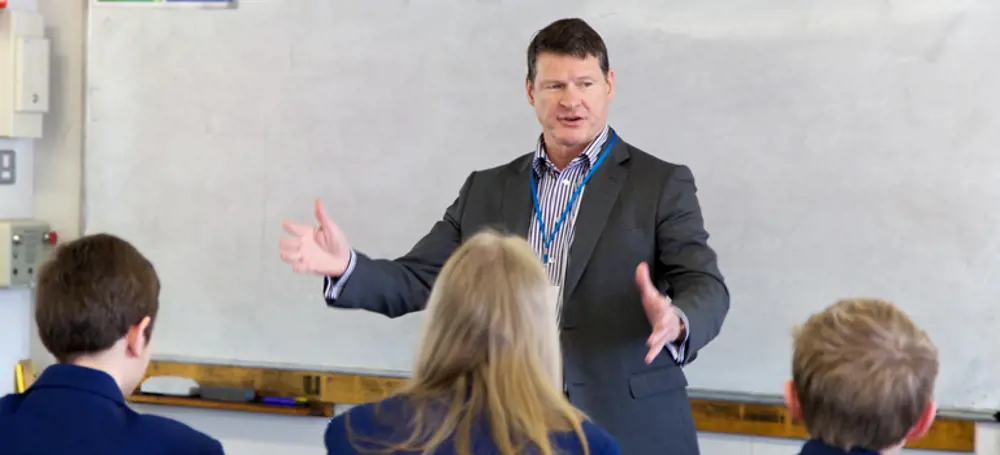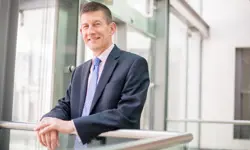
Energy with connections
For someone whose engineering career started in the oil and gas business – running refineries and managing shipping fleets among other jobs – taking on energy distribution could have been a dull career move. After all, in the 1990s, energy transmission was seen as a utility, a matter of taking electricity from large power stations and gas from oilfields and carrying them through national networks of power lines and pipes. Steve Holliday FREng joined National Grid in 2001 with a remit to cast an outsider’s eye over the recently privatised electricity distributor. Holliday soon found himself overseeing a merger that was to bring energy transmission and distribution to the forefront of energy policy. As he puts it: “The fossil fuel industry is interesting, but it is not where things are at in terms of the transformations going on right now.”
Holliday has an distinctive way of describing the fundamental change that he helped to manage in his 15 years at National Grid, 10 of which he spent as the company’s CEO. “When I joined this industry, if a new energy minister got together a dinner of the energy industry in the UK, he or she would sit next to BP and Shell, and you work your way out through National Power and PowerGen. National Grid would be on the outside of the ring. Today, the energy minister would sit next to the CEO of National Grid.”

In 2013, Steve Holliday was presented with an honorary degree from the University of Strathclyde that recognised his contribution to the power and energy sector, and its importance to the Scottish economy © University of Strathclyde
From mining to shipping
Had Holliday’s early career gone to plan, he could have ended up in a part of the energy business that had left the room long before dinner arrived. After studying A levels in maths, physics and chemistry, Holliday changed his mind about a career in medicine and decided that mining engineering looked interesting. “Mining appeared to be global and exciting,” he says. It also fitted in with one of his childhood pursuits: “I had done a lot of caving as a kid.”
Holliday went to the University of Nottingham to study the subject but soon changed his mind about mining and became interested in the oil industry. “It became fairly clear, very shortly into the course, that I was never going to actually work in the mining industry.”
This was at the beginning of the UK’s North Sea oil boom. Fortunately, Nottingham’s engineering course was flexible. “You could actually choose a petroleum engineering module so I ended up drifting towards the oil industry.”
When he graduated, Holliday applied “to all of the oil companies” hoping to work in the upstream part of the business, finding and recovering oil and gas. Unfortunately, Esso UK, the company he liked and that liked him, was a small player in the upstream business. The good news was that the company liked to pitch promising recruits into the downstream area, which is how Holliday began his engineering career in an oil refinery.
Holliday admits that he had limited knowledge of chemical engineering, but Esso ran what he describes as a two-month chemical engineering deep dive. “I remember thinking to myself that this is quite interesting, perhaps I should become a chemical engineer. It didn’t turn me into one but it gave me an appreciation of chemical engineering.”
Once his education was topped up, Esso set Holliday to work as a process engineer at its Fawley refinery near Southampton on the piping and the shipping terminal where tankers arrived with crude oil. As Holliday describes it, the work, as a process engineer, was “lots of fluid mechanics and mechanical engineering”.
Fawley was one of the places where Esso turned engineering graduates into managers, a process that meant moving between jobs to get to know the business. After three years, Holliday moved into the planning department and energy distribution. “I was scheduling ships into the refinery and working with people about where the ships were coming from in the Middle East. I loved that job.” Was it really engineering? Probably not, Holliday admits, then again, he ripostes, “there is engineering in every job isn’t there?” Planning is where Holliday’s work mattered to the wider world. “You had an important role to play. If there was a problem at night, then they phoned you at home. That is what really excited me, doing something that was relevant and important to others.”
That is what really excited me, doing something that was relevant and important to others
He ended up being promoted to a supervisor, running a part of the operation. “Esso in those days was fantastic at giving young people opportunities,” he says. “At 26, I had about 100 people working for me.”
Holliday spent a lot of time during a maintenance shutdown of the catalytic cracking unit, “crawling through every vessel I possibly could to see how this thing actually worked. It was brilliant.” Someone at Esso must have seen the trail he left: after the shutdown they put him in charge of the plant, a very heavy chemical engineering job.
Two years later, Holliday moved to headquarters to work in oil trading, but within a year it was back to Fawley to run the whole operation. In all, Holliday spent around 13 years at the refinery. “I loved that place. It was just an exciting place to be. There was always something happening. The sense of size, the investment that was going in then was phenomenal, challenging lots of things from the past.” He admits that it was an emotional departure when he drove out for the last time. “I spent a big chunk of my life there and I had wonderful times. I knew that I was never going back.”
Moving upstream
In 1994, Holliday finally received the call from the upstream business that he had wanted to get into as a fresh graduate. He moved to New Jersey in the USA to learn about the natural gas business with responsibility for operations in Australia, Malaysia, Thailand, Indonesia and the new markets of China and Korea that Exxon was trying to get into.
Holliday’s next move was very different. In 1997, he climbed off Exxon’s career escalator and moved from a company with 60,000 to 70,000 employees to a become a board member of a small exploration and production company with just 500 employees. His remit was to expand the business internationally. When his bosses at Exxon asked why he wanted to make the metaphorical jump from a tanker into a rowing boat, he replied that the board position was part of the attraction, with “a different sort of challenge; much more entrepreneurial”. He could also see that times were changing in big oil. “I had had a brilliant 19 years, but the future didn’t look as good as the past in many ways.”
He wasn’t to know it at the time, but the future wouldn’t look that good for small companies either. Oil prices collapsed in 2000 and ENI in Italy acquired his new employer. After a few months working on mergers and acquisitions for ENI, Holliday was head-hunted for a job with National Grid.
Not long privatised, the company ran the UK’s electricity distribution network. Within months of joining National Grid, Holliday was heading up negotiations to take over Transco, the company that operated the UK’s gas network.
This is when Holliday began playing his part in changing the shape of the UK’s energy industry. After signing the Transco deal, Holliday’s next job was to integrate the electricity and gas transmission networks. “I remember going to a few conferences in those days and people saying that there was no logic in putting electricity and gas together; they are so different. No-one would ask that question today.”
With the merger sorted out, in 2003 Holliday took control of the company’s gas distribution business, selling off half of the gas networks that National Grid then owned. “There were diseconomies of scale [increased per-unit costs in the long run] actually. Some of the ideas that I and my team had on how we should run the business were very hard to implement across the whole of Great Britain. We could implement it on a smaller platform and there was an opportunity to create some value by recycling some capital out of that business.”
Splitting the gas networks involved creating “an extensive number of protocols and codes as to how the businesses would interact with each other”. For example, a separate business had to be created to hold and maintain the database of all the gas meters in the UK on behalf of the industry. This plan brought Holliday into ever closer contact with the regulators set up by government to oversee the privatised energy businesses. These contacts moved up a step in 2007 when he became CEO. He was now firmly embedded in the domain of energy policy.
In the last few years, people were often bemoaning how it has been a bumpy road but we are in a revolution actually
Holliday is not one to complain that the UK does not have an energy policy. He has a very different take on the concept. “In the last few years, people were often bemoaning how it has been a bumpy road but we are in a revolution actually.”
As an aside, he observes that while the government talks of not wanting to prescribe the UK’s energy mix, it has in fact done so “in a sort of backdoor way” with last year’s statement that there will be no coal-fired power stations on the system by 2020. “That is half prescribing it isn’t it?”
Holliday may be puzzled by the contradiction in the government’s stance on the fuel mix, but he is no great supporter of coal as an energy source. National Grid has a legal obligation to connect any generation in the UK but personally he is keen on renewable energy. “We have to be agnostic,” he explains, “but that did not mean that we could not be passionate about the science of climate change and that we would certainly do all that we could inside our own business to reduce our carbon footprint. Anything that we can do to facilitate clean energy, we would do.” Inside the energy business, Holliday has been something of a campaigner for measures to mitigate climate change.
Anything that we can do to facilitate clean energy, we would do
There is one area where Holliday is more animated on energy policy – smart meters. He sees smart electricity meters and other technologies as an important part of the UK’s energy strategy but there are limits. “In my mind, one of the most ridiculous decisions in the UK is to put a smart meter on gas. On electricity yes, because you want to be able to control things. You could sign a contract with us at your home that will allow someone to control your power say, ‘when power is above the price of X I want to reduce my load to a minimum please’. With gas, it is called a thermostat.”
Smart electricity meters, on the other hand, can be an important ‘resource’, as Holliday explains with a look at the likely scenarios for the country’s energy supply. National Grid started publishing its own scenarios about five years ago as a part of its legal obligation. The exercise not only guides the company in its thinking on investment but also allows others in the industry to refine their own. He illustrates this with a simple diagram of what the energy mix could look like in 2040, listing nuclear power, solar and wind in three separate quadrants with the fourth given over to ‘flexibility’, which is where smart meters come in.
Even today’s energy mix shows how much has changed over the past decade, and why energy distribution has grown in importance. “In the course of the last six or seven years, we have built a phenomenal renewable energy supply in this country from a standing start. Costs have come down amazingly and they will probably come down further.”
Moving on
After four decades in energy, Holliday maintains his enthusiasm for the business, especially networks. “I had no idea that I was entering an industry that hitherto had been seen as dull. The word utility says something in terms of its definition, and in the utility industry the networks piece was also seen as perhaps not quite the most exciting. What has actually happened is that the utility industry, that is not a word that you would use any more, is an energy industry at the forefront of innovation because of renewable energy and clean energy. The networks are now the most innovative part of the industry as we think about the rapidly emerging new technologies that are allowing flexible control of power demand.”
Two is that as we go through a revolution in energy, which is fantastic and exciting, we are going to need the most capable, imaginative, cleverest people on the planet to help us to resolve these issues
In the next phase of his career – Holliday talked to Ingenia on his last day in National Grid’s HQ – he will work on another of his passions, ensuring that there are enough young engineers around to bring about that future. “I spent a lot of the last five years of my life promoting engineering and skills to kids. There are two reasons for that. One is that we have got a business that is a baby boomer business, there are lots of natural retirements in the next 10 years. Two is that as we go through a revolution in energy, which is fantastic and exciting, we are going to need the most capable, imaginative, cleverest people on the planet to help us to resolve these issues, in a world in which engineers are in short supply and children are less encouraged than ever to go and study it.”
Holliday reels off numbers to illustrate the problem. “We need about 85,000 engineers a year and we’re producing about 53,000 so we’re massively short every year: the gap is getting bigger and bigger.” This is why he has championed such initiatives as Engineering our future: Inspiring and attracting tomorrow’s engineers, a study carried out by National Grid in partnership with the Royal Academy of Engineering.
more than 50% of doctors in training are female. That wasn’t the case 20 years ago. We can crack it in engineering...I am very proud that 31% of our top 200 executives are female.
He has also campaigned for moves to increase the number of women who become engineers. Once again, he reels off some telling numbers. “Half the state schools in England don’t have a single girl studying A-level physics. Not one. It is extraordinary.” As he says, “more than 50% of doctors in training are female. That wasn’t the case 20 years ago. We can crack it in engineering.” National Grid is doing its bit. “I am very proud that 31% of our top 200 executives are female,” he says. “That has been another huge change actually.”

Steve Holliday teaches a class a Campion School, Warwickshire, as part of Teach First’s Every Child Can coaching programme © Teach First
Career timeline and distinctions
Born, 1956.Awarded a bachelor’s degree in mining engineering, University of Nottingham, 1978.Joined Exxon, 1978. Operations Manager, Fawley Refinery, Southampton, 1988–1991. Board member, British Borneo Oil and Gas, 1997–2001.Joined National Grid as Transmission Director, 2001.Appointed Group Director for National Grid’s UK gas distribution and business services, including the role of Chief Executive Officer of Transco, 2003–2006.Non-executive Director, Marks and Spencer, 2004–2014.Chief Executive Officer, National Grid, 2007–2016.Fellow of the Royal Academy of Engineering, 2010. Awarded honorary doctorate, University of Nottingham, 2012. Chairman, Crisis, 2012–present. Awarded honorary degree for contributions to the power and energy sector, University of Strathclyde, 2013. Vice Chair, Business in the Community, 2014–present. Lead Non-Executive Director and Board Member, Department for Environment, Food and Rural Affairs, 2016–2017.
One way to recruit bright young people is to show them how exciting engineering can be. He then throws out another statistic: 57% of all jobs require a background in STEM (science, technology, engineering and medicine). “How do you make people realise that STEM is a good pathway through to work and demystify what that looks like as well? Engineering is not nuts and bolts and dirty spanners and things, which is what it is perceived as.”
Most senior engineers deliver the same message on education and training. In Holliday’s case, he has put in time and effort. At National Grid, he has championed such schemes as working with young offenders and the ‘School Power’ programme that aims to enthuse primary school pupils about engineering and science. He is also vice-chairman of the Careers & Enterprise Company, a joint enterprise with government and industry, which “is all around trying to get businesses into schools more, and get kids more inspired”. Set up in 2014, it supports companies and schools in working together.
It is the place to be. It is incredible. I wish I was 23 and starting out
If Holliday’s enthusiasm for engineering, especially in his own area of energy, can rub off on some of those young people, the UK might get somewhere. “It is the place to be. It is incredible. I wish I was 23 and starting out.”
***
This article has been adapted from "Energy with connections", which originally appeared in the print edition of Ingenia 68 (September 2016).
Contributors
Michael Kenward OBE
Author
Keep up-to-date with Ingenia for free
SubscribeRelated content
Energy

Algae-powered architecture
An apartment block in Hamburg in Germany has been built that uses microalgae placed within its façade to generate heat and biomass. Jan Wurm, an associate director at Arup, was one of the chief designers of the energy system. He talked about the concept, execution and results from the world’s first photobioreactor.

Digital hydraulics for wind energy and beyond
Research that has helped change the technology for harnessing wind energy has many other applications. The digital hydraulics system devised by Artemis Intelligent Power has received many accolades, the latest being the winner of the 2015 MacRobert Award.

New energy pioneers
London-based BBOXX supplies solar-powered battery boxes to customers in developing countries. Their remote monitoring and battery management system was one of the winners of the 2015 Bloomberg New Energy Finance Award.

Building a sustainable career
Dr Shaun Fitzgerald FREng has moved between academia, strategic consulting and running his own business, and is now the new Director of the Royal Institution. A career that started in geothermal energy research moved to natural ventilation in buildings, leading to a business that has changed the nature of building design.
Other content from Ingenia
Quick read

- Environment & sustainability
- Opinion
A young engineer’s perspective on the good, the bad and the ugly of COP27

- Environment & sustainability
- Issue 95
How do we pay for net zero technologies?
Quick read

- Transport
- Mechanical
- How I got here
Electrifying trains and STEMAZING outreach

- Civil & structural
- Environment & sustainability
- Issue 95